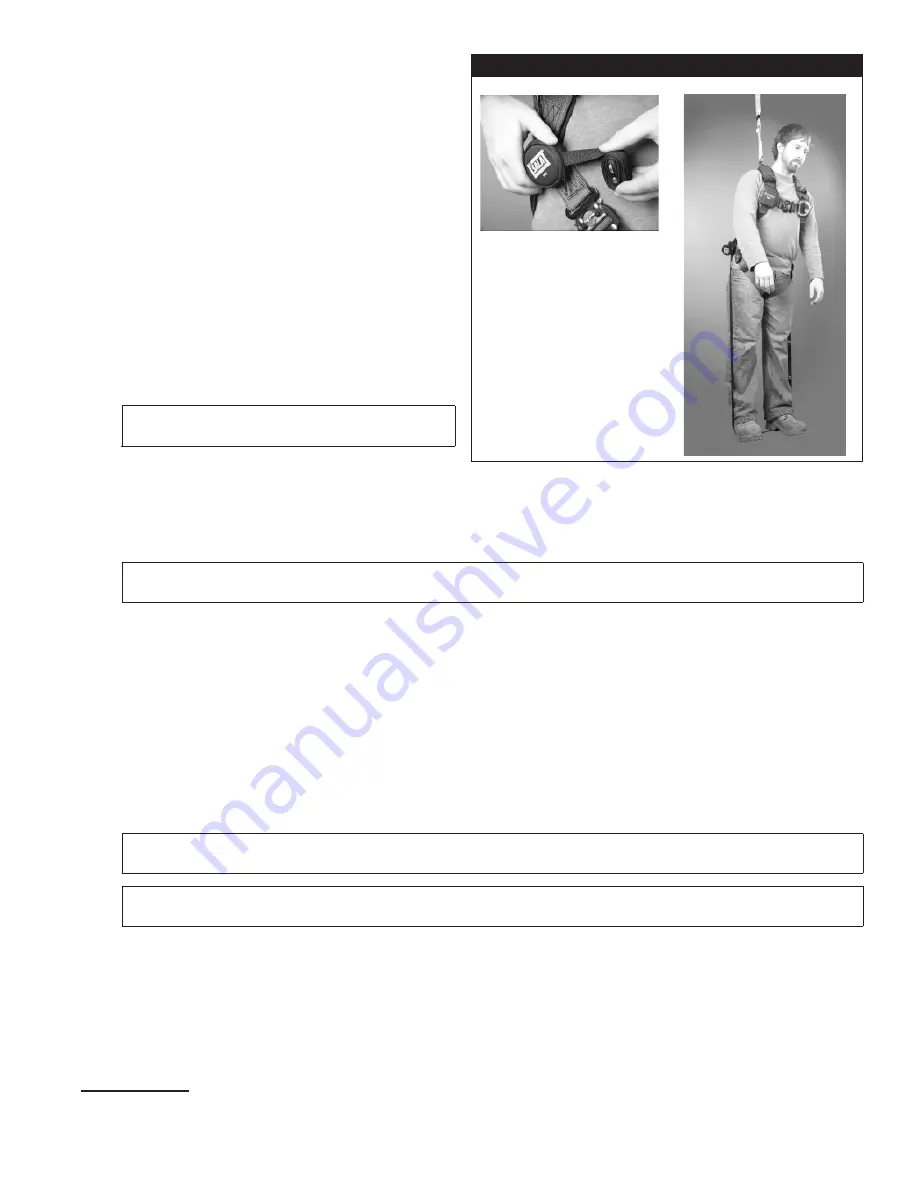
5
3.7 SUSPENSION TRAUMA STRAP:
Some models
of the ExoFit NEX™ Full Body Harness are equipped
with a Suspension Trauma Strap (Figure 3) to
help prolong allowable suspension time in the
event of a fall from height. It should only be
used in situations where a fall has occurred or for
training. To use the Suspension Trauma Strap:
Step 1.
Unzip the Trauma Strap Pouch on each
hip of the harness and deploy the
Suspension Straps (Figure 3A).
Step 2.
Raise the ends of the straps to access
the hook and loops. Insert the hook
into the loop that provides the desired
strap length.
Step 3.
Lower the Suspension Strap and step
onto the strap to alleviate pressure
of the harness leg straps on the legs
(Figure 3B). Adjust the hook/loop
combination for optimal comfort.
WARNING: Seek medical attention following
a suspension.
Figure 3 - Suspension Trauma Straps
A
B
4.0 TRAINING
It is the responsibility of the purchaser and the user of this equipment to assure that they understand these
instructions and are trained in the correct care and use of this equipment. They must also be aware of the
operating characteristics, application limits, and the consequences of improper use of this equipment.
IMPORTANT: Training must be conducted without exposing the user to a fall hazard. Training should be
repeated on a periodic basis.
5.0 INSPECTION
5.1 i-Safe™ RFID TAG:
The i-Safe™ RFID tag on the ExoFit NEX™ Harness (see Figure 4) can be used in
conjunction with the i-Safe handheld reading device and the web based portal to simplify inspection and
inventory control and provide records for your fall protection equipment.
5.2 FREQUENCY:
Before each use inspect the full body harness according to Section 5.3. The harness must
be inspected by a competent person
3
, other than the user, at least annually. Record the results of each
formal inspection in the Periodic Examination and Repair History at the back of the
“General Instructions for Use and
Maintenance” (5902392)
, or use the i-Safe™ inspection web portal to maintain your inspection records. If you
are a
fi
rst-time user, contact Capital Safety (see back cover). If you have already registered, go to: www.
capitalsafety.com/isafe. Follow instructions provided with your i-Safe handheld reader or on the web portal
to transfer your data to your web log.
IMPORTANT: If the full body harness has been subjected to fall arrest or impact forces it must be
immediately removed from service and destroyed.
IMPORTANT: Extreme working conditions (harsh environments, prolonged use, etc.) may require
increasing the frequency of inspections.
5.3 INSPECTION:
Inspect the ExoFit NEX™ Full Body Harness as follows:
Step 1.
Inspect harness hardware (buckles, D-rings, pads, loop keepers, vertical torso
adjusters):
These items must not be damaged, broken, distorted, and must be free of sharp
edges, burrs, cracks, worn parts, or corrosion. PVC coated hardware must be free of cuts, rips,
tears, holes, etc. in the coating to ensure non-conductivity. Ensure that release tabs on buckles
work freely and that a click is heard when the buckle engages. Inspect vertical torso adjusters for
proper operation. Ratchet knobs should turn with ease in a clockwise direction and should only
turn counterclockwise when the knob is pulled out.
3 Competent
Person: One who is capable of identifying existing and predictable hazards in the surroundings or working
conditions which are unsanitary, hazardous, or dangerous to employees, and who has authorization to take prompt
corrective measures to eliminate them.






































